
An example of how to calculate the crash rate for an intersection
- Subject:
- Algebra
- Engineering
- Material Type:
- Activity/Lab
- Homework/Assignment
- Author:
- Peyton Ratto
- Date Added:
- 12/14/2021

An example of how to calculate the crash rate for an intersection

Creating motor mounts. Created by Karl Wendt.

CMS.611J / 6.073 Creating Video Games is a class that introduces students to the complexities of working in small, multidisciplinary teams to develop video games. Students will learn creative design and production methods, working together in small teams to design, develop, and thoroughly test their own original digital games. Design iteration across all aspects of video game development (game design, audio design, visual aesthetics, fiction and programming) will be stressed. Students will also be required to focus test their games, and will need to support and challenge their game design decisions with appropriate focus testing and data analysis.
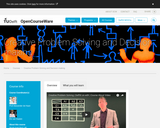
Explore complex, multi-actor systems in which one factor influences all other factors. For instance, how innovative energy technologies merge into the existing energy system, or how new transport possibilities impact current processes. Armed with this information, learn to decide whether they should be further developed, consider possible negative results and weigh associated costs.
There are multiple ways to make decisions, but one way proven to be very useful is the analytical approach – a methodology for making the problem explicit and rationalising the different potential solutions. In short: analysis based support of decision making, design and implementation of solutions.
Creative Problem Solving and Decision Making as a course teaches you this method.
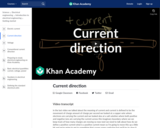
The positive sign for current corresponds to the direction a positive charge would move. In metal wires, current is carried by negatively charged electrons, so the positive current arrow points in the opposite direction the electrons move. This has been the sign convention for 270 years, ever since Ben Franklin named electric charges with + and - signs. This convention came about 150 years before the discovery of the electron. Created by Willy McAllister.

It’s a new VET curricula, aimed to help VET students to take advantage of the huge opportunities created by Industry 4.0, through the adaption of drone technology, in order to start a new business or to expand already existing companies.
The document is available in 5 languages (EN, RO, PL, GR, IT). All language versions are available for download on www.edudrone-project.eu

DASHlink is a virtual laboratory for scientists and engineers to disseminate results and collaborate on research problems in health management technologies for aeronautics systems. Managed by the Integrated Vehicle Health Management project within NASA's Aviation Safety program, the Web site is designed to be a resource for anyone interested in data mining, IVHM, aeronautics and NASA.

Welcome to DC Electrical Circuit Analysis, an open educational resource (OER). The goal of this text is to introduce the theory and practical application of analysis of DC electrical circuits. It is offered free of charge under a Creative Commons non-commercial, share-alike with attribution license. For your convenience, along with the free pdf and odt files, print copies are available at a very modest charge. Check my web sites for links.

D-Lab: Energy offers a hands-on, project-based approach that engages students in understanding and addressing the applications of small-scale, sustainable energy technology in developing countries where compact, robust, low-cost systems for generating power are required. Projects may include micro-hydro, solar, or wind turbine generators along with theoretical analysis, design, prototype construction, evaluation and implementation. Students will have the opportunity both to travel to Nicaragua during spring break to identify and implement projects. D-Lab: Energy is part of MIT’s D-Lab program, which fosters the development of appropriate technologies and sustainable solutions within the framework of international development. This course is an elective subject in MIT’s underGraduate / Professional Energy Studies Minor. This Institute-wide program complements the deep expertise obtained in any major with a broad understanding of the interlinked realms of science, technology, and social sciences as they relate to energy and associated environmental challenges.

D-Lab: Energy offers a hands-on, project-based approach that engages students in understanding and addressing the applications of small-scale, sustainable energy technology in developing countries where compact, robust, low-cost systems for generating power are required. Projects may include micro-hydro, solar, or wind turbine generators along with theoretical analysis, design, prototype construction, evaluation and implementation. Students will have the opportunity both to travel to Nicaragua during spring break to identify and implement projects.
D-Lab: Energy is part of MIT's D-Lab program, which fosters the development of appropriate technologies and sustainable solutions within the framework of international development.
This course is an elective subject in MIT’s undergraduate Energy Studies Minor. This Institute-wide program complements the deep expertise obtained in any major with a broad understanding of the interlinked realms of science, technology, and social sciences as they relate to energy and associated environmental challenges.

D-Lab Development addresses issues of technological improvements at the micro level for developing countries—in particular, how the quality of life of low-income households can be improved by adaptation of low cost and sustainable technologies. Discussion of development issues as well as project implementation challenges are addressed through lectures, case studies, guest speakers and laboratory exercises. Students form project teams to partner with mostly local level organizations in developing countries, and formulate plans for an IAP site visit. (Previous field sites include Ghana, Brazil, Honduras and India.) Project team meetings focus on developing specific projects and include cultural, social, political, environmental and economic overviews of the countries and localities to be visited as well as an introduction to the local languages.

D-Lab Development addresses issues of technological improvements at the micro level for developing countries—in particular, how the quality of life of low-income households can be improved by adaptation of low cost and sustainable technologies. Discussion of development issues as well as project implementation challenges are addressed through lectures, case studies, guest speakers and laboratory exercises. Students form project teams to partner with mostly local level organizations in developing countries, and formulate plans for an IAP site visit. (Previous field sites include Ghana, Brazil, Honduras and India.) Project team meetings focus on developing specific projects and include cultural, social, political, environmental and economic overviews of the countries and localities to be visited as well as an introduction to the local languages.

D-Lab: Design addresses problems faced by undeserved communities with a focus on design, experimentation, and prototyping processes. Particular attention is placed on constraints faced when designing for developing countries. Multidisciplinary teams work on semester-long projects in collaboration with community partners, field practitioners, and experts in relevant fields. Topics covered include design for affordability, design for manufacture, sustainability, and strategies for working effectively with community partners and customers. Students may continue projects begun in EC.701J D-Lab I: Development.
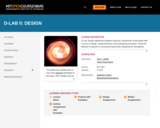
D-Lab: Design addresses problems faced by undeserved communities with a focus on design, experimentation, and prototyping processes. Particular attention is placed on constraints faced when designing for developing countries. Multidisciplinary teams work on semester-long projects in collaboration with community partners, field practitioners, and experts in relevant fields. Topics covered include design for affordability, design for manufacture, sustainability, and strategies for working effectively with community partners and customers. Students may continue projects begun in EC.701J D-Lab I: Development.
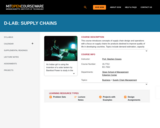
This course introduces concepts of supply chain design and operations with a focus on supply chains for products destined to improve quality of life in developing countries. Topics include demand estimation, capacity planning and process analysis, inventory management, and supply chain coordination and performance. We also cover issues specific to emerging markets, such as sustainable supply chains, how to couple product design with supply chain design and operation, and how to account for the value-adding role of a supply chain. A major aspect of class is the student projects on supply chain design or improvement.
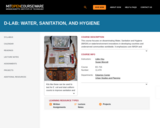
This course focuses on disseminating Water, Sanitation and Hygiene (WASH) or water/environment innovations in developing countries and underserved communities worldwide. It emphasizes core WASH and water/environment principles, culture-specific solutions, tools for start-ups, appropriate and sustainable technologies, behavior change, social marketing, building partnerships, and the theory and practice of innovation diffusion.

This course focuses on disseminating Water, Sanitation and Hygiene (WASH) or water/environment innovations in developing countries and underserved communities worldwide. It emphasizes core WASH and water/environment principles, culture-specific solutions, tools for start-ups, appropriate and sustainable technologies, behavior change, social marketing, building partnerships, and the theory and practice of innovation diffusion.

This course will explore the current frontiers of the world of RNA biology with primary research papers to trace how the original odd detail sometimes leads to major discoveries. As we discuss the different transcripts and processing events that enable this exciting diversity of RNA functions, we invite you to read landmark papers with us, think critically, and ask new questions, as we marvel at the wonders of RNA.
This course is one of many Advanced Undergraduate Seminars offered by the Biology Department at MIT. These seminars are tailored for students with an interest in using primary research literature to discuss and learn about current biological research in a highly interactive setting. Many instructors of the Advanced Undergraduate Seminars are postdoctoral scientists with a strong interest in teaching.

Short Description:
Drone Delivery of CBNRECy – DEW Weapons: Emerging Threats of Mini-Weapons of Mass Destruction and Disruption (WMDD) is our sixth textbook in a series covering the world of UASs and UUVs. Our textbook takes on a whole new purview for UAS / CUAS/ UUV (drones) – how they can be used to deploy Weapons of Mass Destruction and Deception against CBRNE and civilian targets of opportunity. We are concerned with the future use of these inexpensive devices and their availability to maleficent actors. Our work suggests that UASs in air and underwater UUVs will be the future of military and civilian terrorist operations. UAS / UUVs can deliver a huge punch for a low investment and minimize human casualties.
Long Description:
Drone Delivery of CBNRECy – DEW Weapons: Emerging Threats of Mini-Weapons of Mass Destruction and Disruption (WMDD) is our sixth textbook in a series covering the world of UASs & UUVs. Our textbook takes on a whole new purview for UAS / CUAS/ UUV (drones) – how they can be used to deploy Weapons of Mass Destruction and Deception against CBRNE and civilian targets of opportunity. We are concerned with the future use of these inexpensive devices and their availability to maleficent actors. Our work suggests that UASs in air and underwater UUVs will be the future of military and civilian terrorist operations. UAS / UUVs can deliver a huge punch for a low investment and minimize human casualties.
Repeating, we are concerned with the future use of these inexpensive devices and their availability to maleficent actors. As I write this description, we are on the 56th day of the savage invasion of Ukraine by Russia under President Putin. The Russian drone fleet numbers are above 500. They have had five years to grow their fleet. Russia currently uses them for domestic security, Syrian operations, and defense. (Facon, 2016) In the conflict, Russian troops seriously outnumber Ukrainian forces. However, on February 8, 2022, a Forbes report stated that Ukraine used 20 Turkish TB-2 drones to hit Russian targets and offset some of Russia’s enormous military advantages. (Malsin, 2022) According to Fox News, on February 27, 2022, President Putin ordered nuclear deterrent forces status raised to “special combat readiness” (Colton, 2022)
News like this in just one conflict suggests that UASs in air and underwater UUVs will be the future of military and civilian terrorist operations. UAS / UUVs can deliver a huge punch for a low investment and minimize human casualties. Our team believes that China is watching both the United States’ Neville Chamberlain appeasement strategy and the aggressive nature of Russia in its full-scale invasion of its neighbor. This portends that Taiwan is the next meal on the global plate. Unfortunately, two other state actors have season tickets: Iran and North Korea. Iran’s drone fleet is impressive and has caused other Gulf states’ inventories to escalate (UAE, Kingdom of Saudi Arabia, Egypt, Iraq, Jordan, Israel) (Barrie, 2021). North Korea (NK) lies about its air power. However, one report states that NK will have drones with stealth capability. (Choi, 2021) Maybe. According to Datablog, the US has the most drones and is best equipped for warfare. China, of course, might dispute these statistics. (DATABLOG, 2012) However, carrying a big stick doesn’t count anymore in the UAS’s future military play without the will to use it.
Our Wildcat team is composed of some impressive SMEs. We divided the work into four sections. Section 1 covers Chemical, Biological, Radiation, Nuclear, Explosive (CBRNE) weapons and payloads delivered by unmanned vehicles. Here we look at the technologies and damage delivered by drones as mini weapons of mass destruction and disruption. Chapter 7 concentrates on Deception and how drones can be used in PSYOPS and INFOWAR. Section 2 concentrates on Directed Energy Weapons (DEW), projectiles payloads, satellite killers, port disrupters, and cyberweapons against CBRN assets. Section 3 looks at policy considerations, risk assessments of threats and vulnerabilities of drone-based WMDD / DEW, practical crime scene investigations for hot zones, and unique challenges of responding to bioterrorism and chemical threats and attacks delivered by drones. Our final Section 4 concludes with social networking implications and DRONESEC security and tracking tools of the trade.
Over two years of solid research by a team of eleven SMEs is incorporated into our book. We trust you will enjoy reading it as much as we have in its writing. There are nightmares aplenty.
Word Count: 150837
ISBN: 978-1-944548-44-5
(Note: This resource's metadata has been created automatically by reformatting and/or combining the information that the author initially provided as part of a bulk import process.)

This course is an introductory exploration of documentary film theory and production, focusing on documentaries about science, engineering, and related fields. Students engage in digital video production as well as social and media analysis of science documentaries. Readings are drawn from social studies of science as well as from documentary film theory. The courses uses documentary video making as a tool to explore the worlds of science and engineering, as well as a tool for thinking analytically about media itself and the social worlds in which science is embedded. The course includes a hands-on lab component devoted to digital video production, in addition to classroom lectures and in-class film screenings.